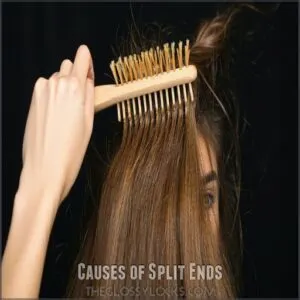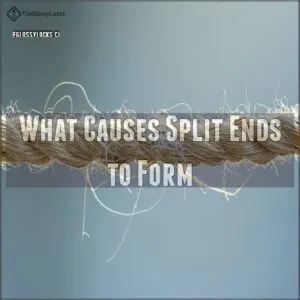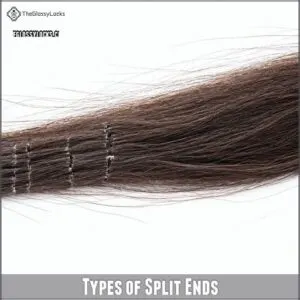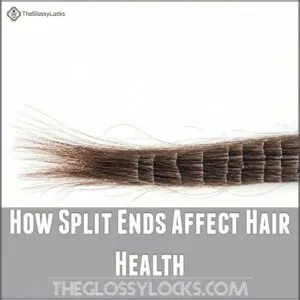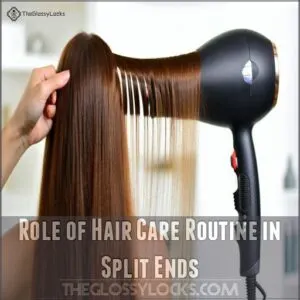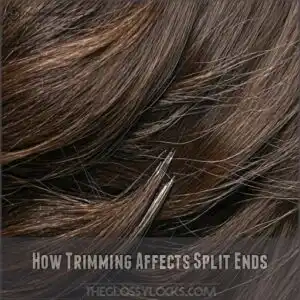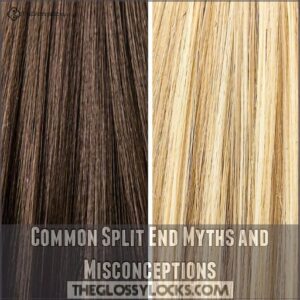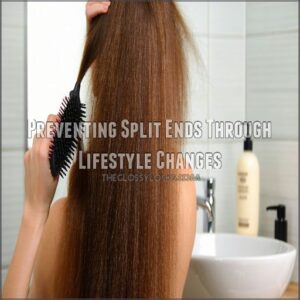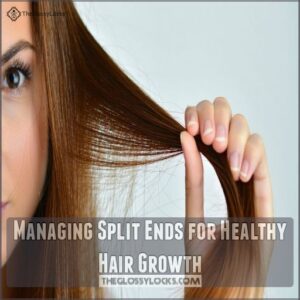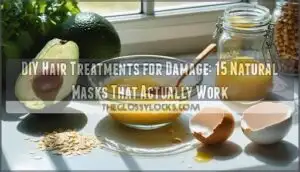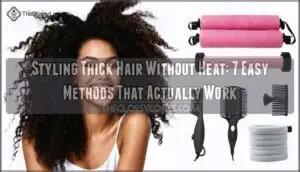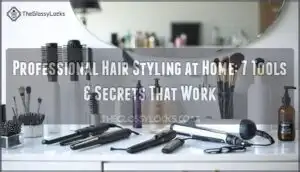This site is supported by our readers. We may earn a commission, at no cost to you, if you purchase through links.
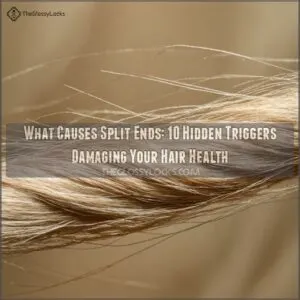 Your hair’s worst enemies might be hiding in plain sight.
Your hair’s worst enemies might be hiding in plain sight.
Split ends occur when your hair’s protective outer layer breaks down, often due to heat styling, chemical treatments, and aggressive brushing.
You’ll also face damage from environmental stressors like sun exposure and dry air.
Think of your hair like your favorite sweater – too much rough handling, and those fibers start to unravel.
While regular trims help manage split ends, understanding factors like heat styling tools and chemical treatments that can damage hair by stripping moisture and causing split ends can be prevented by learning how to trim split ends at home. While regular trims help manage split ends, understanding the root causes lets you prevent them.
From your morning shower routine to that trusted flat iron, seemingly innocent habits could be secretly sabotaging your hair’s health.
Table Of Contents
- Key Takeaways
- Causes of Split Ends
- What Causes Split Ends to Form
- Types of Split Ends
- How Split Ends Affect Hair Health
- Causes of Split Ends in Specific Hair Types
- Role of Hair Care Routine in Split Ends
- How Trimming Affects Split Ends
- Common Split End Myths and Misconceptions
- Preventing Split Ends Through Lifestyle Changes
- Managing Split Ends for Healthy Hair Growth
- Frequently Asked Questions (FAQs)
- Why are split ends bad?
- What are the causes and symptoms for split-ends in the hair?
- What causes split ends & dead ends?
- What causes gnarly Split Ends?
- What causes split ends to fray?
- Where do Split Ends occur?
- How do I stop getting split ends?
- What is the main cause of split ends?
- Can you actually repair split ends?
- What deficiency causes split ends?
- How quickly do split ends form after a trim?
- Can certain foods prevent or worsen split ends?
- Do split ends affect hair color and dye absorption?
- Why do some people rarely get split ends?
- Does water quality impact split end formation?
- Conclusion
Key Takeaways
- You’re causing most split ends through daily habits like aggressive brushing, heat styling without protection, and harsh chemical treatments that break down your hair’s protective outer layer.
- Your environment plays a bigger role than you think – UV rays, pollution, and humidity fluctuations gradually weaken your strands, making them more prone to splitting.
- You can’t repair split ends once they form – despite what products claim, regular trims are essential, especially for short hair which may need trims as often as every 2-4 weeks to maintain a fresh look. The only real solution is getting regular trims every 6-8 weeks to prevent splits from traveling up the hair shaft.
- You’ll prevent split ends better by incorporating hair-healthy habits: using heat protectants, switching to silk pillowcases, protecting your hair from environmental stress, and maintaining proper nutrition with biotin, iron, and protein-rich foods.
Causes of Split Ends
Looking at your hair ends and seeing those pesky splits? You’re not alone. Split ends are like tiny warning signals that your hair’s crying out for attention.
Think of your hair strands as delicate threads that, over time, can start to fray and unravel. These splits happen when your hair’s protective outer layer gets compromised, exposing the inner structure to damage.
It’s worth noting that regular trims, such as getting your split ends trimmed every 6-8 weeks, can help prevent further breakage and promote healthy hair growth.
While you might be tempted to blame your styling routine, the truth is that split ends can sneak up on you from multiple directions. From your morning shower routine to that cozy pillowcase you sleep on, everyday habits play a bigger role than you’d think. Understanding these triggers is your first step toward healthier, stronger hair.
What Causes Split Ends to Form
Your hair faces daily battles against multiple enemies that can weaken its protective outer layer and create those pesky split ends.
From harsh brushing to chemical treatments, you’ll find that these everyday habits are slowly but surely damaging your strands, leading to the inevitable split at the tips.
Environmental Stress
Your daily outdoor adventures take a bigger toll on your hair than you might think.
Environmental stressors act like silent assassins, gradually weakening your strands.
Here’s what’s secretly damaging your hair:
- Harsh UV rays penetrate your hair shaft, breaking down proteins
- City pollution particles stick to strands, creating a grimy barrier
- Humidity fluctuations make your hair expand and contract repeatedly
Think of these environmental factors as tiny warriors, constantly challenging your hair’s natural defenses.
Mechanical Actions
While environmental factors play their part, everyday actions can be sneaky culprits behind those pesky split ends.
Think about it – brushing wet hair, aggressive towel-drying, and tight hairstyles all create friction that weakens your strands.
Even sleeping on cotton pillowcases can rough up your hair cuticles.
The constant tugging, pulling, and rubbing gradually breaks down the hair shaft, leading to those frustrating splits.
Chemical Treatments
Chemical treatments might seem like a quick fix for your dream hair, but they’re often silent destroyers of hair health.
Beyond the mechanical stress from brushing, these treatments pack a powerful punch.
Here’s how chemical processes damage your strands:
- Bleaching strips away protective proteins
- Hair dye penetrates and weakens the cortex
- Perms break and reshape internal bonds
- Relaxers alter your hair’s natural structure
Think twice before booking that next chemical service.
Dehydration
Dehydrated strands act like brittle twigs, ready to snap at the slightest touch.
Think of your hair’s moisture like a protective shield – when it’s gone, split ends march in.
Low water intake, dry indoor air, and skipping conditioning all steal essential moisture from your locks.
Combat this by staying hydrated, using hair masks regularly, and keeping a humidifier nearby to maintain your hair’s natural moisture balance.
Weakened Old Strands
At the tips of your hair, you’ll find the oldest parts of each strand – think of them as senior citizens of your hair family.
These mature ends have weathered years of styling, washing, and environmental stress, making them more prone to splitting.
Like a well-worn rope, these aged sections gradually lose their protective outer layer and elasticity, becoming increasingly vulnerable to damage and breakage.
Excessive Brushing
Daily brushing might seem like basic hair care, but you’re probably overdoing it.
When you brush too aggressively or frequently, you’re actually creating microscopic tears in your hair’s cuticle layer.
This damage weakens your hair shaft and leads to split ends, especially if you’re using the wrong brush type.
For healthier hair, stick to gentle detangling 1-2 times daily using a wide-tooth comb or flexible bristle brush.
Types of Split Ends
You’ll find eight distinct types of split ends that can affect your hair, from the common Y-shaped splits to the more severe tree-like damage.
Each type reveals a different story about your hair’s health and the specific kind of stress it’s experiencing, whether from heat styling, chemical treatments, or everyday wear and tear.
Double Split
You’ve probably spotted those Y-shaped frays at your hair ends – that’s a double split, the most common type of hair damage.
When your hair’s protective outer layer breaks down, the strand splits into two distinct parts, creating a telltale Y-shape.
This typically happens from heat styling, aggressive brushing, or chemical treatments, and it’s usually your first warning sign that your hair needs some TLC.
Partial Split
On the journey to healthier hair, you might spot partial splits lurking near your ends.
These sneaky damage signs appear as small, Y-shaped splits that haven’t fully separated yet.
Think of them as early warning signals – they’re usually caused by everyday stress on your hair shaft, especially if you’ve got color-treated or chemically processed locks.
Regular trims can help prevent split ends through the process of hair breakage prevention. Catching them early helps prevent more serious hair breakage later.
Tree Split
Right alongside the most severe forms of hair damage, tree splits branch out like a miniature tree along your hair shaft. This advanced type of split end signals significant structural damage that’s spread beyond the tip.
When you spot these, it’s time for a trim.
Look out for these telltale signs:
- Multiple splits cascading up both sides
- Rough, frayed appearance
- Visible branching patterns
- Brittle, fragile texture
Fork Split
Everyone’s dealt with fork splits – those pesky three-way breaks that make your hair look like tiny pitchforks.
They’re a clear sign your strands are crying out for moisture and protection.
Here’s what you need to know about these troublesome splits:
| Characteristic | Description |
|---|---|
| Appearance | Three-pronged split |
| Main Cause | Severe dehydration |
| Common Location | Hair ends |
| Warning Signs | Rough texture |
| Treatment | Immediate trim |
These splits often indicate your hair’s been exposed to excessive heat or chemical treatments.
Y-Split
Like a wishbone waiting to snap, Y-splits are the most common type of split end you’ll encounter.
These distinctive formations resemble an upside-down Y at the hair’s tip, signaling your strands are crying out for attention.
Here’s what makes Y-splits particularly concerning:
- They’re often the first sign of developing hair damage
- Without intervention, they’ll travel up your hair shaft
- Heat styling dramatically accelerates their formation
Triple Split
While Y-splits might be common, triple splits take hair damage to another level.
Think of them as a fork in the road that splits three ways instead of two.
You’ll spot these troublemakers when two separate fibers break away from your main hair strand, creating a three-pronged split.
They’re often caused by aggressive brushing, heat styling, or chemical treatments gone wrong.
Feather Split
Feather splits creep up along one side of your hair strand, creating a delicate pattern that looks just like a bird’s feather.
This type of damage often signals hair porosity issues, which can be transformed from low to high through various treatments and methods how to change hair porosity. This type of damage often signals deeper issues with your hair care routine.
Here’s what typically causes these distinctive splits:
- Rough towel-drying habits
- Sleeping with wet hair
- Using metal hair ties too frequently
- Excessive heat styling without protection
These splits can quickly travel up your hair shaft if left untreated.
Baby Split
Baby splits are the early warning signs you don’t want to ignore.
Unlike their feathery cousins, these tiny splits appear as barely noticeable frays at your hair’s ends.
Think of them as split ends in training – they’re smaller than typical Y-splits but just as troublesome.
If you spot these miniature splits, it’s your hair’s way of saying it needs attention before the damage spreads.
How Split Ends Affect Hair Health
You’ll notice your hair becoming weaker and more brittle as split ends progress up the hair shaft, damaging its protective outer layer.
When left untreated, these splits can travel further up your strands and cause breakage, making your hair appear thinner and more damaged over time.
Damage to Hair Shaft
Picture your hair shaft as a protective shield – when split ends strike, they’re actually breaking through this armor.
You can learn more about hair shaft damage and how to address it on this website.
Each split creates tiny tears in your hair’s outer layer, leading to serious damage.
Here’s what happens:
- The protective cuticle layer starts peeling away
- Essential proteins and moisture escape through these gaps
- Your hair becomes more vulnerable to environmental stress
Weakened Hair Structure
Beyond surface damage, split ends affect your hair’s inner structure, much like a building with weakened support beams.
When the protective cuticle layer breaks down, your hair loses elasticity and becomes more porous.
This means less protein retention and moisture control.
Think of it as your hair’s natural armor getting compromised – making each strand more vulnerable to environmental stressors and styling damage.
Split Ends Progression
Throughout your hair’s growth cycle, split ends don’t just sit idle – they’re actively climbing up your hair shaft like tiny troublemakers.
Once a split forms, it’ll continue splitting unless stopped.
Here’s what happens:
- The initial split creates a weak point in your hair’s protective layer
- Daily stress causes the split to travel upward
- Without intervention, splits can progress several inches up the strand
Hair Breakage
As split ends work their way up your hair shaft, they’re like tiny dominoes that trigger a chain reaction of breakage.
When your hair snaps, it’s not just losing length – the breakage weakens your entire strand, making it more prone to frizz and tangles.
Think of it as a ladder where each broken rung makes the whole structure shakier, compromising your hair’s overall strength and appearance.
Causes of Split Ends in Specific Hair Types
You’ll find that your hair type plays a major role in how split ends develop, with dry, damaged, and chemically treated hair being particularly vulnerable to splitting.
Color-treated or processed hair is more likely to notice split ends forming faster, especially when combined with regular heat styling or environmental stress.
Dry Hair

Dry hair acts like a magnet for split ends, especially when your strands are crying out for moisture.
Here’s what happens to your hair when it’s parched:
- Natural oils can’t travel down the hair shaft efficiently
- The protective cuticle layer becomes brittle and starts flaking
- Using natural ingredients like coconut oil or avocado oil can help with hydration, as seen in the dry hair treatment guide.
- Your scalp might overproduce oil to compensate
- Hair strands lose their elasticity and become prone to breakage
That’s why regular deep conditioning and proper hydration are your best friends against split ends.
Damaged Hair
Damaged hair becomes a breeding ground for split ends, especially when your strands have lost their natural elasticity.
Regular use of chemical hair dyes can further weaken your hair’s protective cuticle layer, making it more susceptible to breakage and splitting.
Your hair’s protective cuticle layer weakens from daily wear and tear, making it more susceptible to breakage and splitting.
High porosity hair absorbs too much moisture, while low porosity resists it – both scenarios leading to weakened strands.
Regular deep conditioning and gentle handling can help restore hair health.
Color-Treated Hair
You’ve taken the plunge into color-treated hair, but those vibrant hues come with hidden costs to your strands.
Color processing weakens your hair’s protective layer, making it more prone to splitting, especially if you’re lightening your natural shade.
When considering further chemical treatments like perming, it’s important to follow proper best perm for color treated hair techniques to minimize damage.
Here’s what happens to your colored locks:
- Each dye session strips away natural oils
- The cuticle becomes rough and porous
- Your hair loses essential proteins needed for strength
Chemically Treated Hair
Chemical treatments, while offering style flexibility, can be rough on your locks.
Just like color treatments, perms and straightening processes break down your hair’s protein structure, making split ends more likely to appear.
Regular trims every 6 weeks and a diet rich in protein, omega-3 fatty acids, zinc, biotin, vitamin E, and iron, can help mitigate the damage caused by these treatments, read more about how do split ends stop hair growth.
Here’s what common treatments do to your strands:
| Treatment Type | Impact on Hair |
|---|---|
| Perms | Breaks protein bonds |
| Straightening | Weakens hair shaft |
| Bleaching | Strips natural oils |
| Relaxers | Alters hair structure |
| Keratin | Temporary protein coating |
Role of Hair Care Routine in Split Ends
You’re probably damaging your hair more than you think with your daily hair care routine, from harsh shampoos to aggressive towel-drying habits that create microscopic tears in your strands.
Your well-intended beauty rituals, including frequent washing and heat styling, can actually be the hidden culprits behind those pesky split ends that you’re trying so hard to avoid.
Over-Shampooing
Washing your hair daily might seem like good hygiene, but it’s stripping away natural oils faster than your scalp can replenish them.
This constant over-shampooing disrupts your hair’s natural moisture balance, leading to brittle strands and split ends.
Using a gentle Best Shampoo For Dry Hair (Best Shampoo Options) can help mitigate this issue.
Think of your hair like a delicate fabric – the more you wash it, the quicker it wears down.
Try spacing out your washes to every 2-3 days instead.
Insufficient Conditioning
Missing essential conditioning sessions starves your hair of important nutrients, leading to brittle strands and split ends.
Your hair’s natural protective barrier weakens without proper moisturizing, making it vulnerable to damage.
Here’s what happens when you skip conditioning:
- Hair cuticles remain open, exposing inner layers to damage
- Natural oils get stripped away, causing moisture loss
- Strands become more prone to tangling and breakage
Heat Styling Damage
Your regular hot tools routine might feel like a necessary evil, but it’s wreaking havoc on your strands.
Every time you fire up that flat iron or blow dryer without proper protection, you’re basically cooking your hair.
Heat styling strips away moisture and weakens the protective outer layer, making your hair more prone to splitting.
Think of it like leaving a piece of paper too close to a flame.
Improper Towel-Drying
Just like heat styling, aggressive towel-drying can wreak havoc on your strands.
Think of your wet hair as delicate silk – rubbing it vigorously with a rough cotton towel creates friction that tears up the cuticles.
Instead, gently squeeze out excess water with a microfiber towel, moving from roots to tips.
This simple switch can make the difference between healthy hair and split-end central.
How Trimming Affects Split Ends
You can’t fix split ends once they’ve formed, but regular trimming stops them from climbing up your hair shaft and causing more damage.
Getting your hair trimmed every 6-8 weeks works like a reset button, removing damaged ends and giving your hair a fresh start for healthy growth.
Preventing Split Ends Progression
Three key strategies halt split ends in their tracks: regular trims, protective styling, and mindful brushing.
Think of split ends like a tear in fabric – once they start, they’ll keep going unless you stop them.
By trimming every 6-8 weeks, you’ll prevent damage from climbing up your strands.
Meanwhile, gentle detangling and protective styles minimize daily wear and tear.
Promoting Healthy Hair Growth
Regular trimming works like a reset button for your hair’s growth journey.
While keeping those split ends in check, healthy trimming practices stimulate your scalp and support natural hair growth cycles.
Think of it as giving your hair a fresh start – removing damaged ends helps nutrients flow better through each strand.
Plus, when you maintain this routine, you’ll notice stronger, more resilient growth from root to tip.
Recommended Trimming Frequency
While hair grows about half an inch monthly, experts recommend trimming every 6-8 weeks to stay ahead of split ends.
Your trim schedule might need adjusting based on your hair type and styling habits – those who heat style frequently should visit their stylist more often.
If you’re growing out your hair, you can stretch appointments to 8-12 weeks, but watch for signs of splitting.
Benefits of Regular Trims
Getting your hair trimmed does more than just keep split ends at bay.
You’ll notice hair that’s easier to manage, grows healthier, and looks fuller right away.
Think of it like pruning a plant – removing damaged ends signals your scalp to focus energy on strong, new growth.
Plus, you’ll spend less time battling tangles and breakage, making your daily styling routine smoother.
Common Split End Myths and Misconceptions
You’ve probably noticed the endless stream of products promising to magically fix your split ends, but it’s time to separate fact from fiction.
Let’s clear up some common misconceptions about split ends that might be leading you down the wrong path to hair health.
Can Split Ends Be Repaired?
Despite what miracle products might promise, you can’t actually repair split ends once they’ve formed.
Think of split ends like a frayed rope – once those fibers separate, there’s no way to fuse them back together.
Your only real solution is trimming them off.
The good news? While you can’t fix existing splits, you can prevent new ones from forming with proper hair care.
Effectiveness of Split End Treatments
You’ve probably seen those miracle split end treatments promising to "heal" and "repair" your damaged strands.
Here’s the truth: once a hair strand splits, it can’t be magically fused back together.
Those fancy serums and treatments might temporarily smooth the appearance of split ends by coating the hair shaft, but they’re just Band-Aids.
The only real solution is trimming those damaged ends off.
Role of Hair Masks in Split Ends
While hair masks aren’t a magical fix for existing split ends, they play a key role in prevention.
Think of them as your hair’s weekly spa treatment – they deeply moisturize and strengthen strands, making them less prone to splitting.
Regular masking (once or twice weekly) with ingredients like keratin, argan oil, or coconut oil helps maintain hair elasticity and protect the cuticle from future damage.
Preventing Split Ends Through Lifestyle Changes
You’ll be surprised to learn that your everyday habits, from what you eat to how well you sleep, can make or break your hair’s health.
While you can’t completely prevent split ends, you can noticeably reduce their occurrence by making smart lifestyle choices that protect and nourish your hair from the inside out.
Diet and Nutrition
Your hair’s health starts from the inside out, and proper nutrition plays a key role in preventing split ends.
Think of your hair like a garden that needs the right nutrients to flourish.
Here are four essential nutrients for stronger, split-end-free hair:
- Biotin-rich foods like eggs and nuts
- Iron-packed leafy greens
- Omega-3 fatty acids from fish
- Protein from lean meats or legumes
Sleep and Relaxation
Getting proper sleep plays a surprising role in preventing split ends.
Silk pillowcases aren’t just a luxury – they minimize friction that leads to hair breakage while you toss and turn.
Build a relaxing bedtime routine by gently braiding your hair or wrapping it in a silk scarf.
High stress levels can actually impact your hair’s health, so try meditation or deep breathing before bed.
Reducing Environmental Stress
Just like you protect your skin from environmental damage, your hair needs a shield against nature’s harsh elements.
Beyond getting enough rest, protecting your strands from external stressors makes a huge difference in preventing split ends.
Here’s how to guard your hair against environmental damage:
- Wear a hat or UV-protective spray when you’re out in the sun
- Use an anti-pollution hair serum in urban areas
- Cover your hair with a silk scarf on windy days
- Keep humidity at bay with anti-frizz products
- Switch to gentler styling methods during cold weather
Managing Split Ends for Healthy Hair Growth
Regular trims can’t keep split ends at bay if you’re unknowingly causing cuticle damage through friction and twisting, especially if you’re sleeping on a pillowcase that’s not reducing hair friction. You’ll need more than just regular trims to keep those pesky split ends at bay, as proper hair care habits play a key role in maintaining healthy growth.
While you can’t repair split ends once they’ve formed, you can prevent new ones from developing by following some proven maintenance strategies that protect your strands from root to tip.
Hair Care Tips for Split Ends
Every strand tells a story of your daily hair care routine.
Smart habits like using a wide-tooth comb on wet hair and applying leave-in conditioner can prevent split ends from spreading.
Nourishing your hair with a Split End Repair Oil can help lock in moisture and reduce breakage.
Deep conditioning masks once a week restore moisture balance, while protective hairstyles minimize friction.
Remember to trim every 6-8 weeks, as it’s the only proven way to eliminate existing splits.
Avoiding Damage From Styling Tools
Your styling tools might feel like trusted allies, but they can secretly sabotage your hair health.
To prevent damage, always use heat protectants before reaching for that blow dryer or flat iron.
Keep temperatures below 365°F for fine hair and 410°F for coarse textures.
Start with the lowest heat setting, and never style wet hair – moisture trapped inside can literally steam-cook your strands.
Frequently Asked Questions (FAQs)
Why are split ends bad?
Split ends weaken your hair structure, leading to frizz, tangles, and further breakage up the hair shaft.
They’ll make your hair look dull and damaged, potentially causing significant length loss if left untreated.
What are the causes and symptoms for split-ends in the hair?
Damaged hair fibers create frayed, brittle ends that split upward.
You’ll notice rough textures, tangles, and uneven strands from heat styling, chemical treatments, excessive brushing, and environmental stress.
Regular trims help prevent further damage.
What causes split ends & dead ends?
Nearly 90% of women experience hair damage daily. Environmental stress, excessive brushing, chemical treatments, and dehydration weaken your hair’s protective layer, causing those pesky splits and dead ends you’re battling with.
What causes gnarly Split Ends?
Your hair’s worst enemies are daily habits: excessive heat styling, rough brushing, and chemical treatments.
Environmental factors like sun and wind don’t help either.
Skipping conditioner and regular trims makes things even worse.
What causes split ends to fray?
Those pesky hair endings start to fray when you’re rough with brushing, expose them to harsh chemicals, or blast them with heat styling.
Hair endings are vulnerable because natural oils can’t reach the ends easily.
Where do Split Ends occur?
Split ends typically form at the tips of your hair strands where they’re oldest and most vulnerable to damage.
Split ends will usually start appearing 3-4 inches from the scalp, working their way down to the ends.
How do I stop getting split ends?
Like a protective shield for your hair, regular trims every 6-8 weeks, deep conditioning, and using heat protectants are your best defense.
Don’t forget to brush gently and sleep on silk pillowcases.
What is the main cause of split ends?
Daily wear and tear from brushing, heat styling, and chemical treatments break down your hair’s protective layer.
You’ll also see more damage if you’re skipping conditioner or using harsh products on your strands.
Can you actually repair split ends?
Despite what hair products claim, split ends are often a sign of dry and brittle hair, which lacks natural shine, you can’t repair split ends – they’re permanently damaged hair fibers.
Your only real solution is trimming them off.
Regular trims every 6-8 weeks help maintain healthier-looking hair.
What deficiency causes split ends?
Nutritional deficiencies in biotin, iron, and protein can trigger split ends in your hair.
You’ll also notice them more if you’re low on vitamins A, C, and E, plus essential minerals like zinc.
How quickly do split ends form after a trim?
Split ends typically start forming 6-8 weeks after your trim, depending on your hair care routine.
You’ll notice them sooner if you frequently use heat styling tools or skip protective treatments.
Can certain foods prevent or worsen split ends?
Your hair is like a garden that thrives on nutrients.
You’ll prevent split ends by eating protein-rich foods and omega-3s.
Excessive sugar and processed foods can weaken your strands from within.
Do split ends affect hair color and dye absorption?
Damaged ends can’t absorb hair dye evenly, leading to patchy color results.
You’ll notice the frayed sections take color differently or appear lighter than healthy hair.
Regular trims help guarantee consistent dye absorption.
Why do some people rarely get split ends?
People with naturally oily hair, gentle styling habits, and protective hairstyles often dodge split ends. You’ll notice they also maintain regular trims and avoid harsh treatments that weaken strands.
Does water quality impact split end formation?
Every drop counts in terms of hair health!
Hard water minerals can weaken your hair’s structure, making it prone to splitting.
Installing a shower filter can help protect against mineral buildup and damage.
Conclusion
Like a delicate thread in a tapestry, your hair needs gentle handling to maintain its strength.
Split ends are a common problem, but understanding their causes is the first step to preventing them.
Now that you understand what causes split ends, you’re better equipped to protect your strands from damage.
Remember, prevention is your best defense – from proper heat protection to regular trims.
By making small changes in your daily routine and being mindful of these hidden triggers, you’ll keep those pesky split ends at bay and maintain healthier, more resilient hair.

